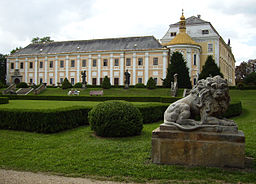Lysá nad Labem
| Lysá nad Labem | |||
| Town | |||
|
Castle
|
|||
|
|||
| Country | Czech Republic | ||
|---|---|---|---|
| Region | Central Bohemian | ||
| District | Nymburk | ||
| Commune | Lysá nad Labem | ||
| River | Elbe | ||
| Elevation | 183 m (600 ft) | ||
| Coordinates | 50°12′N 14°50′E / 50.200°N 14.833°ECoordinates: 50°12′N 14°50′E / 50.200°N 14.833°E | ||
| Area | 33.65 km2 (12.99 sq mi) | ||
| Population | 8,988 (2013) | ||
| Density | 267/km2 (692/sq mi) | ||
| First mentioned | 1291 | ||
| Mayor | Jiří Havelka | ||
| Timezone | CET (UTC+1) | ||
| - summer (DST) | CEST (UTC+2) | ||
| Postal code | 289 22 | ||
| Statistics: statnisprava.cz | |||
| Website: www.mestolysa.cz | |||
Lysá nad Labem (Czech pronunciation: [ˈlɪsaː ˈnad labɛm]; German: Lissa an der Elbe) is a town in Nymburk District in the Central Bohemian Region of the Czech Republic, situated on the Labe (Elbe) river. The historical centre of the town was established as a part of the Town Monument Zone in 2003.
Lysá nad Labem is firstly mentioned in the Cosmas chronicle. In the 13th century, a castle was built here and until the reign of the Luxembourgs, the town was property of the Czech queens. Since 1291, there has been evidence of Lysá being a town. In that year, Queen Guta issued a charter to unite the settlements of the Lysá estate into one economic unit. During the Hussite wars the town suffered a lot. At the turn of the 15th and 16th century, the Smiřický family of Smiřice rebuilt the castle into the palace. In 1548 Ferdinand I, Holy Roman Emperor added Lysá to the intimate dominion as a hunting centre. The sustainable development of the town was stopped by the Thirty Years' War. Armed uprising, which burst in the town during the violent recatholisation, is the proof of the presence of the evangelical element until the Battle of White Mountain. The immediate reaction to the religious tolerance was the establishment of the group of the Reformed church, whose compound is still one of the cultural monuments of the town.
In 1647, Lysá was acquired by the empire general Johann von Sporck and then the town began to flourish. After the general’s death, his son Franz Anton von Sporck began to reign. He made the most important changes in 1696 when the Augustinian monastery was restored and the new parish church and the chapel of Three Kings were built. Nowadays, the palace serves as a House for seniors.
...
Wikipedia





